LAB REPORT
Science and Technology Making Headlines
April 13, 2018

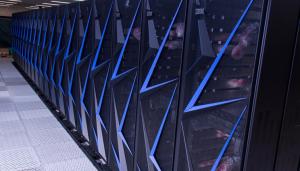
A request for proposals has gone out for the next generation of high performance computers.
Exascale shifts to high gear
Secretary of Energy Rick Perry this week announced the release of a request for proposals (RFP) for the development of at least two new exascale supercomputers, including Lawrence Livermore National Laboratory’s next-generation system code-named “El Capitan.”
Scheduled to be deployed at Lawrence Livermore and Oak Ridge national laboratories in the 2021-23 timeframe, the new supercomputers funded through the RFP, potentially worth up to $600 million each, will be follow-on systems to the first U.S. exascale system authorized by Perry this past June. That system is named Aurora and it is under development at Argonne National Laboratory (ANL) and scheduled to come online in 2021.
El Capitan will be LLNL’s next Advanced Technology system after Sierra, which is scheduled for acceptance later this year and will enable breakthroughs in both science and industry through modeling and simulation, high-performance data analysis and artificial intelligence and machine learning applications.
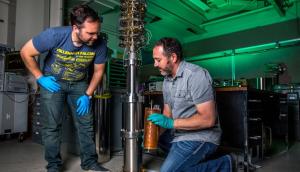
LLNL postdoc Nathan Woollett and LLNL staff scientist and ADMX co-spokesman Gianpaolo Carosi work on the cryostat system in which LLNL places its test microwave cavity. Photo by George Kitrinos/LLNL
Tuning in to dark matter
This week, the Axion Dark Matter Experiment (ADMX) unveiled a new result that places it in a category of one: It is the world’s first and only experiment to have achieved the necessary sensitivity to “hear” the telltale signs of dark matter axions. This technological breakthrough is the result of more than 30 years of research and development, with the latest piece of the puzzle coming in the form of quantum-enabled devices that allows ADMX to listen for axions more closely than any experiment ever built.
ADMX was commissioned and built at Lawrence Livermore in 1994 and operated there until it moved to the University of Washington in 2010 to undergo a series of upgrades.
Forty years ago, scientists theorized a new kind of low-mass particle that could solve one of the enduring mysteries of nature: what dark matter is made of. The search for that particle has just begun.

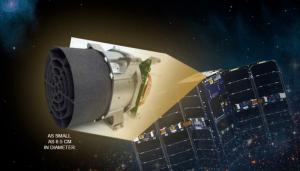
An LLNL-developed monolithic telescope is 8.5 centimeters in diameter and is mounted on a nanosatellite developed by Tyvak. The demonstration system was launched earlier this year.
Building a better telescope
Lawrence Livermore researchers have developed and tested an optical telescope system that can be used for Earth and space observation.
The team built and tested several designs for high-resolution monolithic optical telescope systems, fabricated from a single piece of fused silica, for deployment on small satellites.
After successfully testing one of the designs in 2016 on a high-altitude NASA aircraft, the Livermore team partnered with Tyvak, a commercial satellite developer, to integrate the monolithic telescope into a “CubeSAT” (a type of modularized miniaturized satellite).
The lightweight telescope measures as small as 8.5 centimeters in diameter and is so compact that the satellite it is mounted on can be smaller than traditional space vehicles. One advantage of the telescope is that it can take images of space in daytime and night during its 95-minute orbit of Earth, whereas terrestrial telescopes can only take images at night.

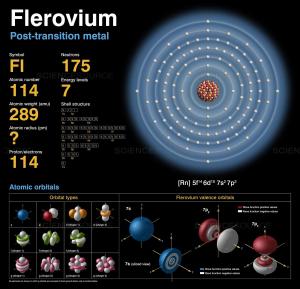
Flerovium, element 114 on the periodic table, behaves differently than what is expected.
Element 114 might be out of line
“Flerovium might not belong [where it currently sits in the periodic table], so in other words Mendeleev’s table is no longer true,” said chemist John Despotopulos. His team at Lawrence Livermore National Laboratory, wants to capture the superheavy element in a molecular cage to finally settle questions about its chemical nature.
Only about 90 atoms of element 114 have ever been made, but these were sufficient to spark a debate over whether it really belongs in group 14, the same group as carbon, silicon and lead. Elements within a group should show similar properties and reactivity. “But once you hit element 114, that’s where predictions start to deviate, that’s where elements start to not behave like you would expect,” Despotopulos said.
Surface adsorption experiments have been inconclusive: Some results indicate that flerovium is as volatile and unreactive as radon, others seem to show that it behaves more like mercury. Despotopulos wants to use simple organic chemistry to understand the superheavy element’s true place in the periodic table.

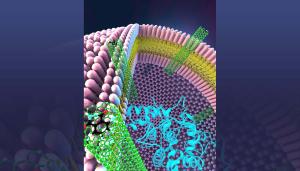
Livermore researchers Eric Meshot (left) and Ngoc Bui evaluate the uniformity of a carbon nanotube (CNT) array on a 4-inch wafer. Gaps between the CNTs are filled with a vapor-deposited polymer to block the passage of any organism or substance excluded by the CNTs.
Closing the door on contaminants
A new, breathable material that also can block biological or chemical threats could offer comfortable protection for people working in contaminated environments or dangerous military zones.
The bottom layer of the material features carbon nanotube pores embedded within a flexible synthetic polymer film. These pores are just a few nanometers across -- too small for bacterial or viral cells to squeeze through, but wide enough for sweat to escape.
The top layer offers further protection. It is made of another, spongy polymer that normally allows water and other molecules to pass through. But when the polymer comes into contact with G-series nerve agents -- the family of toxic chemicals that includes sarin gas -- it flattens into a dense sheet that seals over the carbon nanopores underneath. The polymer can be restored to its original state by soaking it in a high-pH chemical broth.
Both layers together are still less than half the thickness of a sheet of paper and could be laid over fabrics without putting the wearer at risk of overheating. That’s an improvement over the typical protective gear that’s permanently sealed against contaminants, said Lawrence Livermore chemical engineer Francesco Fornasiero.





